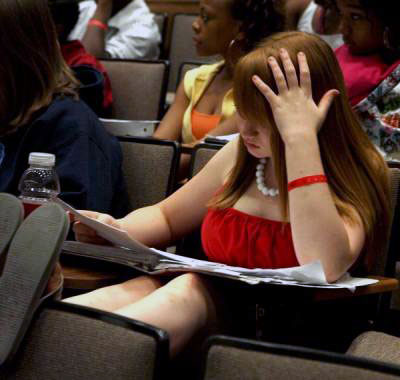All Nonfiction
- Bullying
- Books
- Academic
- Author Interviews
- Celebrity interviews
- College Articles
- College Essays
- Educator of the Year
- Heroes
- Interviews
- Memoir
- Personal Experience
- Sports
- Travel & Culture
All Opinions
- Bullying
- Current Events / Politics
- Discrimination
- Drugs / Alcohol / Smoking
- Entertainment / Celebrities
- Environment
- Love / Relationships
- Movies / Music / TV
- Pop Culture / Trends
- School / College
- Social Issues / Civics
- Spirituality / Religion
- Sports / Hobbies
All Hot Topics
- Bullying
- Community Service
- Environment
- Health
- Letters to the Editor
- Pride & Prejudice
- What Matters
- Back
Summer Guide
- Program Links
- Program Reviews
- Back
College Guide
- College Links
- College Reviews
- College Essays
- College Articles
- Back
To Trust or Not to Trust the Test
Although some people think the ACT, or American College Testing, and SAT, or Standard Aptitude Test, have just recently been created, they are much older than one would think. The first SAT was given in 1926 to 8,040 students, 40% of whom were women (Jacobsen 1.) The test consisted of nine sub-tests and seven verbal tests, which were hand graded by 30 male Princeton and Columbia undergraduates. Since this time, the test scores have been used towards college admission all across the nation. Some argue that these tests do not accurately measure one’s intelligence and are not needed to be accepted into college. Two standardized tests, the ACT and SAT, should not be counted towards college admission because they create an artificial environment and increase the chance that students will cheat to receive a higher score.
The ACT and SAT should not be counted towards college admission because they create an artificial environment that most people will never encounter in everyday life or their specific job. What this means is, when taking these standardized tests, students cannot talk to one another, ask questions about anything, or get up and walk around the room. Most jobs today require working with others and using outside resources to strengthen and come up with more ideas, two things the ACT and SAT prohibit. These tests are counted towards college, which is supposed to help students prepare for the “real world” and ‘real jobs,” so the test that plays a significant part in whether they are accepted into college should go along with this structure as well? The ACT and SAT create an artificial environment that many students will never have to work in once they enter the “real world.”
Additionally, SAT and ACT scores should not be counted towards admission into college because they put so much pressure on students and their futures, that they increase cheating and use of prescription stimulants. A lot of the test takers know the tests affect their future so greatly that they do anything they can to do well. Out of the two million-plus SAT taken in any given year, approximately 4,000 scores are canceled because of suspected cheating (Kessler 1.) Along with cheating, students sometimes turn to drugs to avoid the risk of being caught cheating. These stimulants are extremely dangerous and can cause long term heart and nerve problems. The SAT and ACT create unnecessary stress and pressure on students to do well, causing them to cheat and take prescription stimulants in hopes to improve their performance.
As usual, there are going to be people who disagree with the statement that the ACT and SAT should not be used toward college admission because they believe these standardized tests are the only way to test a person’s intelligence accurately. One may think that every teacher grades differently, but with the ACT and SAT, it is objective and receiving a particular score means the same for all test takers. These tests hold teachers and schools accountable for what they are teaching and how they are grading in class. This point is invalid because just as every teacher is different and grades differently, every student is different. Continuously asking every student the same question in the same format is assuming they are all the same, had the same background, and retain information in the same way. Some students respond to questions more creatively and have evidence to back up their response even if it’s not the “normal” or technically “correct” answer. But, you would never see these answers because there is nowhere on standardized tests to prove different answers.
Because they create an artificial environment and cause students to cheat, the ACT and SAT should not be counted towards college admissions. They do not prepare the test takers for any real life situations that they may have to work in the future, and put unnecessary stress on students that causes them to turn to stimulants and drugs. While the first SAT was given in 1926 and was very different from the one provided today, they both cannot accurately depict one’s intelligence or qualification for college today.

Similar Articles
JOIN THE DISCUSSION
This article has 0 comments.

This is original piece written by myself.